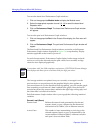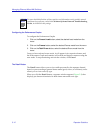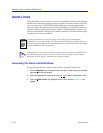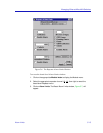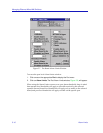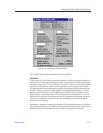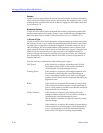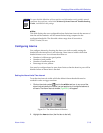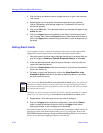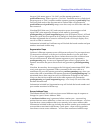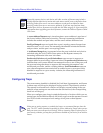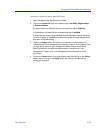
Managing Ethernet MicroLAN Switches
5-18 Alarm Limits
Packets
Use the text box in this Þeld to determine the total number of packets (including
all errors except collisions) that must be processed by the repeater, board, or port
within the user-speciÞed time before an alarm is triggered. Allowable values are 1
to ≈ 4 billion (2
32
-1).
Broadcast Packets
Use the text box in this Þeld to determine the number of broadcast packets that
must be processed by the repeater, board, or port within the user-speciÞed time
before an alarm limit is reached. Allowable values are 1 to ≈ 4 billion (2
32
-1).
% Errors of Type
Use the text box in this Þeld to determine what percentage of packets received by
the repeater, board, or port within the speciÞed time interval can be errors of the
selected type or types before an alarm is triggered. Allowable values are one to
100; percentages will be calculated based on the number of error packets of all
types selected (all those with an check in their check box). Again, a repeater-level
alarm will count all selected error types received by the repeater channel; a
port-level alarm will count only selected error types received by the individual
port. (Remember, on an Ethernet MicroLAN Switch, a board is equivalent to a
repeater channel.)
You can select any combination of the following error types:
CRC Errors If this check box is selected, all packets with Cyclical
Redundancy Check (CRC) errors will be included in
calculating the overall percentage of errors.
Framing Errors If this check box is selected, all misaligned packets will
be included in calculating the overall percentage of
errors. A misaligned packet is one with a non-integral
number of bytes; these are also sometimes referred to as
alignment errors.
Runts If this check box is selected, the number of runt packets
will be included in calculating the overall percentage of
errors. A runt packet is one that is less than the minimum
Ethernet frame size of 64 bytes.
OOW Collisions If this check box is selected, all collisions out of the
standard collision window (51.2 µs) will be included in
calculating the overall percentage of errors.
Out-of-window collisions are typically caused by faulty
network design.
Giants If this check box is selected, the number of giant packets
will be included in calculating the overall percentage of
errors. A giant packet exceeds the maximum Ethernet
frame size of 1518 bytes (excluding the preamble).



